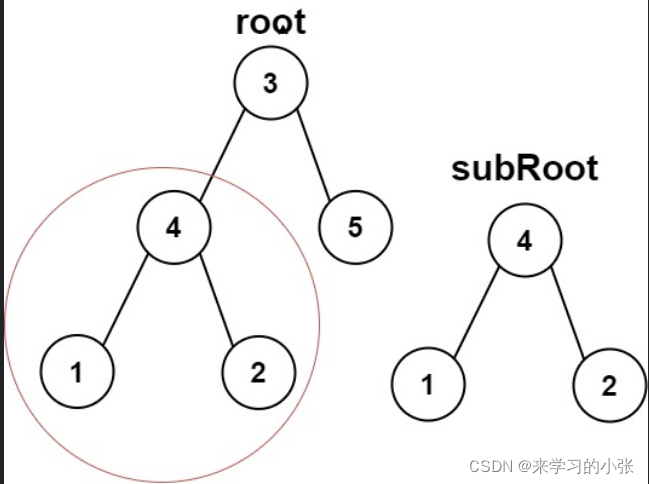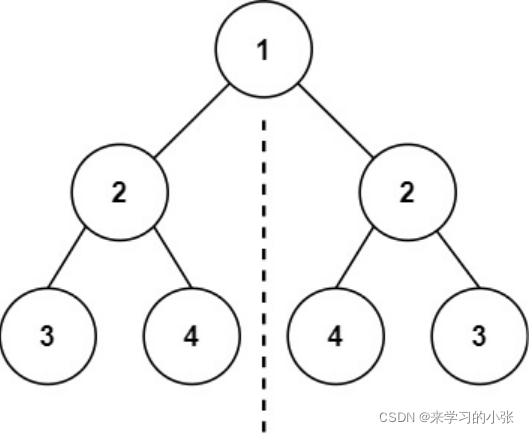目录
一、二叉树的前序遍历
144.二叉树的前序遍历
方法一:
class Solution {
List <Integer> tmp = new ArrayList<>();
public List<Integer> preorderTraversal(TreeNode root) {
if(root == null){
return tmp;
}
tmp.add(root.val);
preorderTraversal(root.left);
preorderTraversal(root.right);
return tmp;
}
}
方法二:
class Solution {
public List<Integer> preorderTraversal(TreeNode root) {
List <Integer> tmp = new ArrayList<>();
if(root == null){
return tmp;
}
tmp.add(root.val);
List<Integer> leftTree = preorderTraversal(root.left);
tmp.addAll(leftTree);
List<Integer> rightTree = preorderTraversal(root.right);
tmp.addAll(rightTree);
return tmp;
方法三:
class Solution {
public List<Integer> preorderTraversal(TreeNode root) {
List<Integer> list = new ArrayList<>();
Stack<TreeNode> stack = new Stack<>();
TreeNode cur = root;
while(cur != null ||!stack.isEmpty()){
while(cur != null){
stack.push(cur);
// System.out.print(cur.val);
list.add(cur.val);
cur = cur.left;
}
TreeNode top = stack.pop();
cur = top.right;
}
return list;
}
}
二、二叉树的中序遍历
94.二叉树的中序遍历
方法一:
class Solution {
public List<Integer> inorderTraversal(TreeNode root) {
List <Integer> tmp = new ArrayList<>();
if(root == null){
return tmp;
}
List <Integer> leftTree = inorderTraversal(root.left);
tmp.addAll(leftTree);
tmp.add(root.val);
List <Integer> rightTree = inorderTraversal(root.right);
tmp.addAll(rightTree);
return tmp;
}
方法二:
class Solution {
List <Integer> tmp = new ArrayList<>();
public List<Integer> inorderTraversal(TreeNode root) {
if(root == null) return tmp;
inorderTraversal(root.left);
tmp.add(root.val);
inorderTraversal(root.right);
return tmp;
}
}
方法三:非递归的方法
class Solution {
public List<Integer> inorderTraversal(TreeNode root) {
Stack<TreeNode> stack = new Stack<>();
List<Integer> tmp = new ArrayList<>();
TreeNode cur = root;
while(cur != null || !stack.isEmpty()){
while(cur != null){
stack.push(cur);
cur = cur.left;
}
TreeNode top = stack.pop();
tmp.add(top.val);
cur = top.right;
}
return tmp;
}
}
三、二叉树的后序遍历
145.二叉树的后序遍历
方法一:
class Solution {
public List<Integer> postorderTraversal(TreeNode root) {
List <Integer> tmp = new ArrayList<>();
if(root == null){
return tmp;
}
List <Integer> leftTree = postorderTraversal(root.left);
tmp.addAll(leftTree);
List <Integer> rightTree = postorderTraversal(root.right);
tmp.addAll(rightTree);
tmp.add(root.val);
return tmp;
}
}
方法二:
class Solution {
List<Integer> tmp = new ArrayList<>();
public List<Integer> postorderTraversal(TreeNode root) {
if(root == null) return tmp;
postorderTraversal(root.left);
postorderTraversal(root.right);
tmp.add(root.val);
return tmp;
}
}
方法三:非递归方法实现后序遍历
class Solution {
public List<Integer> postorderTraversal(TreeNode root) {
List<Integer> tmp = new ArrayList<>();
Stack<TreeNode> stack = new Stack<>();
TreeNode cur = root;
TreeNode pre = null;
while(cur != null || !stack.isEmpty()){
while(cur != null){
stack.push(cur);
cur = cur.left;
}
TreeNode top = stack.peek();
if(top.right == null || top.right == pre){
stack.pop();
tmp.add(top.val);
pre = top; //将pre指向top
}else{
cur = top.right;
}
}
return tmp;
}
}
四、判断两棵树是否相同
100.相同的树
给你两棵二叉树的根节点 p 和 q ,编写一个函数来检验这两棵树是否相同。
如果两个树在结构上相同,并且节点具有相同的值,则认为它们是相同的。
class Solution {
public boolean isSameTree(TreeNode p, TreeNode q) {
if(p == null && q == null) return true;
if((p == null && q != null) ||(p != null && q == null)){
return false;
}
if(p.val != q.val){
return false;
}
return isSameTree(p.left,q.left) && isSameTree(p.right,q.right);
}
五、判断一棵树是否是另一棵树的子树
572.另一棵树的子树
给你两棵二叉树 root 和 subRoot 。检验 root 中是否包含和 subRoot 具有相同结构和节点值的子树。如果存在,返回 true ;否则,返回 false 。
二叉树 tree 的一棵子树包括 tree 的某个节点和这个节点的所有后代节点。tree 也可以看做它自身的一棵子树。

/**
1. Definition for a binary tree node.
2. public class TreeNode {
3. int val;
4. TreeNode left;
5. TreeNode right;
6. TreeNode() {}
7. TreeNode(int val) { this.val = val; }
8. TreeNode(int val, TreeNode left, TreeNode right) {
9. this.val = val;
10. this.left = left;
11. this.right = right;
12. }
13. }
*/
class Solution {
public boolean isSameTree(TreeNode p, TreeNode q) {
//如果两个都为空
if(p == null && q == null){
return true;
}
//一个为空
if((p == null && q != null) ||(q == null && p != null)){
return false;
}
//p q都不为空,但是p,q的值不相等
if(p.val != q.val){
return false;
}
//p q都不为空,且对应的值是相同的
return isSameTree(p.left,q.left) && isSameTree(p.right,q.right);
}
public boolean isSubtree(TreeNode root, TreeNode subRoot) {
if(root == null || subRoot == null){
return false;
}
if( isSameTree(root,subRoot)){
return true;
}
if(isSubtree(root.left,subRoot)){
return true;
}
if(isSubtree(root.right,subRoot)){
return true;
}
return false;
}
}
六、判断一棵树是否为平衡二叉树(AVL树)
平衡二叉树的定义:一个二叉树每个节点的左右两个子树的高度差的绝对值不超过 1 。
解题思路:
- 一棵树如果要是AVL树,那么这颗树的每颗子树都必须是AVL(平衡二叉树)树。
- 求当前根的左树和右树高度,计算绝对值
- 如果没有超过1,只能证明当前根是平衡的,继续判断根的左树和右树,直到找到高度差超过1,则证明其不是平衡的。
方法一:
class Solution {
//求二叉树的高度
public int maxDepth(TreeNode root) {
if(root == null){
return 0;
}
int leftTree = maxDepth(root.left);
int rightTree = maxDepth(root.right);
return ((leftTree > rightTree) ? leftTree + 1 : rightTree + 1);
}
public boolean isBalanced(TreeNode root) {
if(root == null){
return true;
}
//从上往下
int leftTree = maxDepth(root.left);
int rightTree = maxDepth(root.right);
return (Math.abs(leftTree - rightTree)<=1 && isBalanced(root.left) &&isBalanced(root.right));
}
}
方法二:
class Solution {
//求二叉树的高度
public int maxDepth(TreeNode root) {
if(root == null){
return 0;
}
int leftTree = maxDepth(root.left);
int rightTree = maxDepth(root.right);
//在求高度的时候,只要某一个子树不满足就直接结束 从下往上
if(leftTree >=0 && lrightTree >= 0 && Math.abs(leftTree - rightTree) <= 1){
return Math.max(leftTree,rightTree) + 1;
//return ((leftTree > rightTree) ? leftTree + 1 : rightTree + 1);
}else{
return -1;
}
}
public boolean isBalanced(TreeNode root) {
if(root == null){
return true;
}
return maxDepth(root) >= 0;
}
}
七、判断一棵树是否为对称二叉树
101.对称二叉树
给你一个二叉树的根节点 root , 检查它是否轴对称。

class Solution {
public boolean isSymmetricChild(TreeNode leftTree,TreeNode rightTree) {
if(leftTree == null && rightTree == null){
return true;
}
if((leftTree == null && rightTree !=null) || (leftTree != null && rightTree == null)){
return false;
}
if(leftTree.val != rightTree.val){
return false;
}
return isSymmetricChild(leftTree.left,rightTree.right) && isSymmetricChild(leftTree.right,rightTree.left);
}
public boolean isSymmetric(TreeNode root) {
if(root == null){
return true;
}
return isSymmetricChild(root.left,root.right);
}
}
七、二叉树遍历
KY11二叉树遍历
编一个程序,读入用户输入的一串先序遍历字符串,根据此字符串建立一个二叉树(以指针方式存储)。 例如如下的先序遍历字符串: ABC##DE#G##F### 其中“#”表示的是空格,空格字符代表空树。建立起此二叉树以后,再对二叉树进行中序遍历,输出遍历结果。
import java.util.*;
class TreeNode{
public char val;
TreeNode left;
TreeNode right;
public TreeNode (char val){
this.val = val;
}
}
public class Main{
public static int i = 0;
public static TreeNode createTree(String str){
if(str == null){
return null;
}
TreeNode root = null;
if(str.charAt(i) != '#'){
root = new TreeNode(str.charAt(i));
i++;
root.left = createTree(str);
root.right = createTree(str);
}else{
i++;
}
return root;
}
//中序遍历
public static void inorder(TreeNode root){
if(root == null){
return;
}
inorder(root.left);
System.out.print(root.val + " ");
inorder(root.right);
}
public static void main(String[] args){
Scanner scanner = new Scanner(System.in);
String str = scanner.nextLine();
TreeNode root = createTree(str);
inorder(root);
}
}
八、二叉树层序遍历
class Solution {
public List<List<Integer>> levelOrder(TreeNode root) {
//满足结果的要求
List<List<Integer>> ret = new ArrayList<>();
if(root == null){
return ret;
}
//队列的作用是为了实现层序遍历
Queue<TreeNode> queue = new LinkedList<>();
queue.offer(root);
while(!queue.isEmpty()){
int size = queue.size();
List<Integer> list = new ArrayList<>();
while(size!= 0){
TreeNode top = queue.poll();
list.add(top.val);
if(top.left != null){
queue.offer(top.left);
}
if(top.right != null){
queue.offer(top.right);
}
size--;
}
ret.add(list);
}
return ret;
}
}
九、二叉树的最近公共祖先
236.二叉树的最近公共祖先
最近公共祖先的定义为:“对于有根树 T 的两个节点 p、q,最近公共祖先表示为一个节点 x,满足 x 是 p、q 的祖先且 x 的深度尽可能大(一个节点也可以是它自己的祖先)。”
//前序遍历 根-》左-》右
//1.p和q在根节点的两侧,此时root就是最近的公共祖先
//当前根的左树不为空,右树为空,左树找到的节点就是公共祖先
//左树为空,右树不为空,右树找到的节点就是公共祖先
class Solution {
public TreeNode lowestCommonAncestor(TreeNode root, TreeNode p, TreeNode q) {
if(root == null){
return null;
}
if(root == p || root == q){
return root;
}
TreeNode leftTree = lowestCommonAncestor(root.left,p,q);
TreeNode rightTree = lowestCommonAncestor(root.right,p,q);
if(leftTree != null && rightTree != null){
return root;
}
//说明有一个肯定为空
if(leftTree != null ){
return leftTree;
}
if(rightTree != null){
return rightTree;
}
//左右都为空,没有公共祖先
return null;
}
}
方法二:
//1.用两个栈存贮路径
//2.求栈的大小
//3.让栈中多的元素出差值个元素
//4.开始出栈,直到栈顶元素相同,此时就是公共祖先
//node 指定的节点 root:根节点
public boolean getPath(TreeNode root,TreeNode node,Stack<TreeNode> stack){
if(root == null || node == null){
return false;
}
stack.push(root);
if(root == node){
return true;
}
boolean flg = getPath(root.left,node,stack);
if(flg == true) return true;
flg = getPath(root.right,node,stack);
if(flg == true) return true;
stack.pop();
return false;
}
public TreeNode lowestCommonAncestor(TreeNode root, TreeNode p, TreeNode q) {
if(root == null){
return null;
}
Stack<TreeNode> stack1 = new Stack<>();
Stack<TreeNode> stack2 = new Stack<>();
getPath(root,p,stack1);
getPath(root,q,stack2);
int size1 = stack1.size();
int size2 = stack2.size();
if(size1> size2){
int size = size1 - size2;
while(size != 0){
stack1.pop();
size--;
}
while(!stack1.isEmpty() && !stack2.isEmpty()){
if(stack1.peek() == stack2.peek()){
return stack1.pop();
}else{
stack1.pop();
stack2.pop();
}
}
}else{
int size = size2 - size1;
while(size != 0){
stack2.pop();
size--;
}
while(!stack1.isEmpty() && !stack2.isEmpty()){
if(stack1.peek() == stack2.peek()){
return stack1.pop();
}else{
stack1.pop();
stack2.pop();
}
}
}
return null;
}
}
十、二叉搜索树与双向链表
//此题的解决方法其实就是中序遍历,因为要排好序
public class Solution {
public TreeNode prev = null;
public void ConvertChild(TreeNode pCur) {
if(pCur == null){
return;
}
ConvertChild(pCur.left);
//第一次递归,将节点的左边置为空
pCur.left = prev;
if(prev != null){
prev.right = pCur;
}
//将prev移向pCur位置
prev = pCur;
ConvertChild(pCur.right);
}
public TreeNode Convert(TreeNode pRootOfTree) {
//找链表的头节点,直接从根节点出发,往左边找,直到某个节点的left = null
if(pRootOfTree == null){
return null;
}
ConvertChild(pRootOfTree);
TreeNode head = pRootOfTree;
while(head.left != null){
head = head.left;
}
return head;
}
}
十一、从前序与中序遍历序列构造二叉树
class Solution {
public int prindex = 0;
public TreeNode buildTreeChild(int[] preorder, int[] inorder,int inbegin,int inend){
if(inbegin > inend){
return null;//左树或者右树为空
}
TreeNode root = new TreeNode(preorder[prindex]);
//找根节点在中序遍历的数组中的结果
int rootindex = findRootIndex(inorder,inbegin,inend,preorder[prindex]);
prindex++;
root.left = buildTreeChild(preorder,inorder,inbegin,rootindex - 1);
root.right = buildTreeChild(preorder,inorder,rootindex + 1,inend);
return root;
}
//找根节点
public int findRootIndex(int[] inorder,int inbegin,int inend,int key){
for(int i = inbegin;i<= inend;i++){
if(inorder[i] == key){
return i;
}
}
return -1;
}
public TreeNode buildTree(int[] preorder, int[] inorder) {
if(preorder == null || inorder == null) return null;
return buildTreeChild(preorder,inorder,0,inorder.length - 1);
}
}
十二、根据一棵树的中序遍历与后序遍历构造二叉树
class Solution {
public int postindex = 0;
public TreeNode buildTreeChild(int[] postorder, int[] inorder,int inbegin,int inend){
if(inbegin > inend){
return null;//左树或者右树为空
}
TreeNode root = new TreeNode(postorder[postindex]);
//找根节点在后序遍历的数组中的结果
int rootindex = findRootIndex(inorder,inbegin,inend,postorder[postindex]);
postindex--;
root.right = buildTreeChild(postorder,inorder,rootindex + 1,inend);
root.left = buildTreeChild(postorder,inorder,inbegin,rootindex - 1);
return root;
}
//在中序遍历中找根节点
public int findRootIndex(int[] inorder,int inbegin,int inend,int key){
for(int i = inbegin;i<= inend;i++){
if(inorder[i] == key){
return i;
}
}
return -1;
}
public TreeNode buildTree(int[] inorder, int[] postorder) {
if(postorder == null || inorder == null) return null;
postindex = postorder.length - 1
return buildTreeChild(postorder,inorder,0,inorder.length - 1);
}
}
十三、二叉树创建字符串
class Solution {
public void tree2strChild(TreeNode t,StringBuilder sb) {
if(t == null) return;
sb.append(t.val);
if(t.left == null){
if(t.right == null){
return;
}else{
sb.append("()");
}
}else{
sb.append("(");
tree2strChild(t.left,sb);
sb.append(")");
}
if(t.right == null){
return;
}else{
sb.append("(");
tree2strChild(t.right,sb);
sb.append(")");
}
}
public String tree2str(TreeNode root) {
if(root == null) return null;
StringBuilder sb = new StringBuilder();
tree2strChild(root,sb);
return sb.toString();
}
}
十四、二叉树的镜像
public TreeNode Mirror (TreeNode pRoot) {
if(pRoot == null){
return pRoot;
}
if(pRoot.left == null && pRoot.right == null){
return pRoot;
}
TreeNode tmp = pRoot.left;
pRoot.left = pRoot.right;
pRoot.right = tmp;
if(pRoot.left != null){
Mirror(pRoot.left);
}
if(pRoot.right != null){
Mirror(pRoot.right);
}
return pRoot;
}
}
以上。
